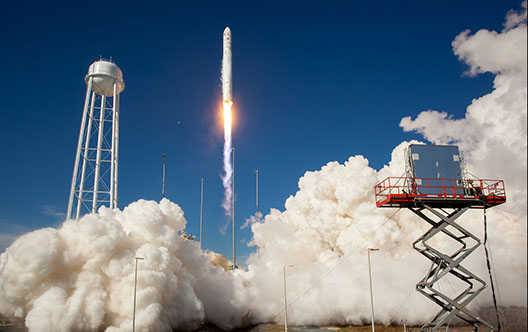 As searchers in the Indian Ocean inch toward finding the disappeared Malaysian Airlines Flight 370, a reminder of the rising role of China in space is that the critical first step in learning the plane’s fate was an innovative analysis of routine satellite data – and that Chinese space assets played an unusually prominent role in the search.
As searchers in the Indian Ocean inch toward finding the disappeared Malaysian Airlines Flight 370, a reminder of the rising role of China in space is that the critical first step in learning the plane’s fate was an innovative analysis of routine satellite data – and that Chinese space assets played an unusually prominent role in the search.
Early in the search operation, China pledged the use of 21 satellites – a public display of peaceful space capabilities that reflects China’s modern space ambitions. Not all of those ambitions, though, may be peaceful.
China recently has looked to outer space as a theater in which to counter the United States’ overwhelming military advantage in the Pacific. The People’s Liberation Army has conducted multiple tests of anti-satellite (ASAT) weapons, fully aware that America’s execution of high-tech, precision-guided combat relies on satellites.
A report last month by the Washington-based Secure World Foundation found that a Chinese rocket launch in May was a test for an anti-satellite “kinetic kill vehicle” that could reach the orbits where most telecommunications satellites are located. The foundation called this “a significant development in China’s ASAT capabilities.”
Space policy specialists have discussed how the US should respond, suggesting that it either “harden” satellites to withstand a punch, or to build more redundant constellations of key satellite systems by simply lofting extra backup satellites into orbit. These approaches would be effective but expensive, perhaps prohibitively so.
Instead, the United States should build its ability to deter any potential aggression in space by expanding two capabilities in which it already holds the advantage. One is the ability to detect an attack and identify its originator for subsequent punishment. The other is simply to monitor and understand what is going on in the bands of orbital space where most satellites operate.
The Pentagon understands this. Its 2014 Quadrennial Defense Review, published last month, calls for “fielding new capabilities to detect and characterize interference with space systems, to enable timely attribution and response.”
The United States had little difficulty in detecting an early Chinese test of its ability to destroy a satellite in space, which came in 2007, when China launched a “kinetic kill vehicle” and used it to smash one of its own disused communications satellites. That attack drew international condemnation, not only for its alarming signal of Beijing’s interest in space combat, but because the collision multiplied the amount of flying debris that poses a hazard to all uses of orbital space.
That condemnation is one reason that China might shift its space warfare efforts toward non-kinetic attacks that could use lasers to “blind” satellites’ sensors or radio signals to jam their communications.
China has possessed a non-kinetic anti-satellite ability since at least 2006, when they temporarily blinded US reconnaissance satellites, and it is likely their methods have only become more effective since then. Detecting and attributing a laser strike is difficult; the attack is quick, lasting as little as little as seconds, and the effects may take an extended time to become apparent. Finding the source of the attack is even harder if the targeted satellite is in a higher orbit, making it visible (and attackable) from a wider swath of the Earth’s surface. Solving this problem will mean using America’s technological advantage in laser detection to increase and improve US monitoring of ground-based laser systems.
The other US deterrent capability is what the military calls “space situational awareness.” The Air Force runs a Geosynchronous Space Situational Awareness Program (GSSAP), for which it recently launched two satellites into geosynchronous orbit – the altitude in space at which a satellite flies in a fixed position as seen from the Earth’s surface. Geosynchronous orbit (called simply “GEO” by space policy specialists) is the highest orbital zone used by large numbers of satellites, and it is where some of the most sensitive security-related satellites are parked.
If, say, a US geosynchronous satellite that detects ballistic missile launches (and thus a potential nuclear attack) were suddenly to flicker out, the GSSAP satellites could help US authorities determine whether the cause was an accident from satellite congestion or a hostile attack that merited retaliation.
While the primary goal of GSSAP and similar systems is to deter conflict, improved space situational awareness and attribution would be critical advantages if hostilities in space were to break out. The ability to discern an enemy’s movements and abilities without reciprocation is an advantage always coveted by military leaders. The US Space Surveillance Network is unparalleled in its ability to monitor objects in outer space, constantly tracking around 23,000 objects ranging in size from baseballs to Buicks. The strengthening of these capabilities would let the Air Force effectively dominate the space domain.
China’s recent advances in testing the elements of space weaponry are troubling. The US focus on building the “new capabilities” cited in the Quadrennial Defense Review is essential for detecting and deterring attacks in space.
Bharath Gopalaswamy is deputy director of the South Asia Center at the Atlantic Council; Dylan Rebstock is an intern at the Atlantic Council’s Eurasia Center.
Image: The Orbital Sciences Corporation Antares rocket is seen as it launches from Pad-0A of the Mid-Atlantic Regional Spaceport (MARS) at the NASA Wallops Flight Facility in Virginia, Sunday, April 21, 2013. (Photo:NASA/Bill Ingalls)
